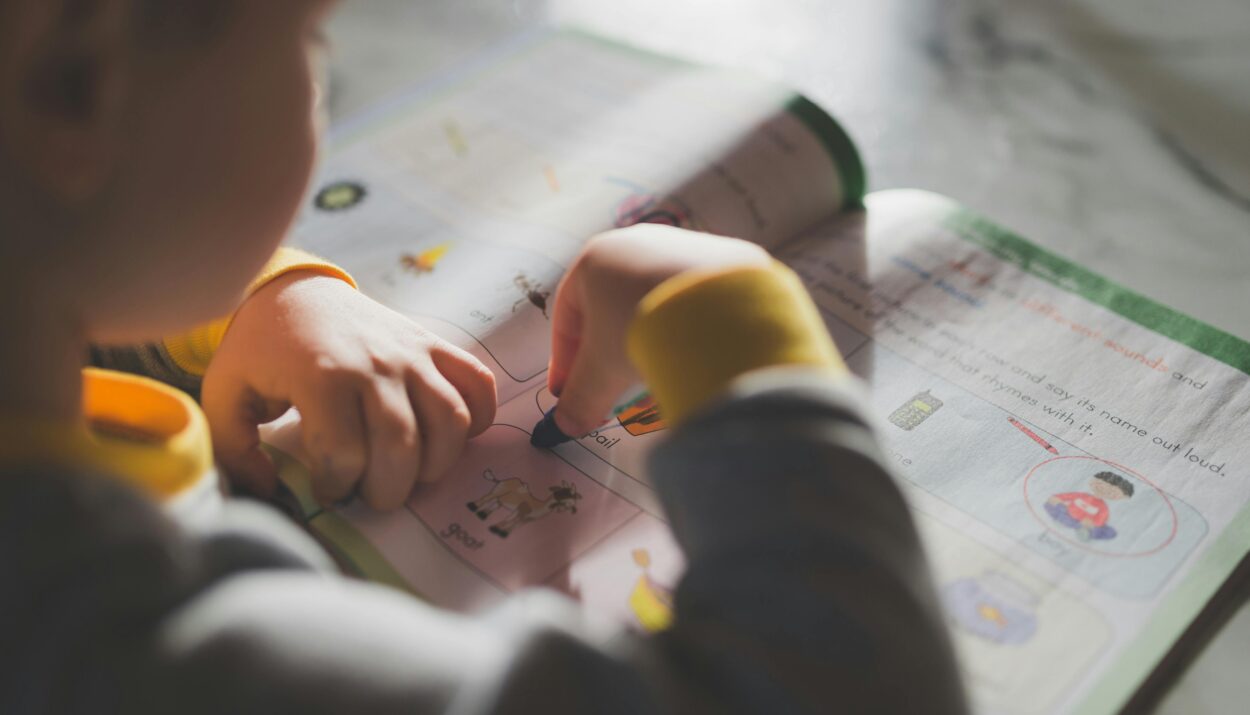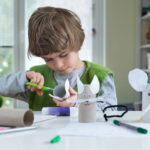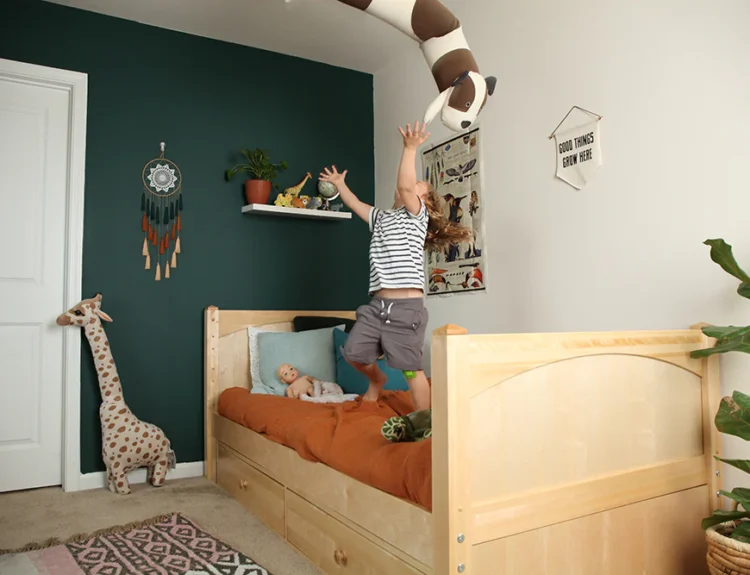Creating a learning corner for my five‑year‑old son, Aanas, has turned everyday moments at home into mini adventures in discovery. I wanted a space that would spark his curiosity, let him choose what to explore, and grow with him as his interests change. What follows is a friendly, step‑by‑step story of how I did it, packed with practical ideas you can copy in a small apartment or a big house. The language is plain, the materials are affordable, and every tip is rooted in real life.
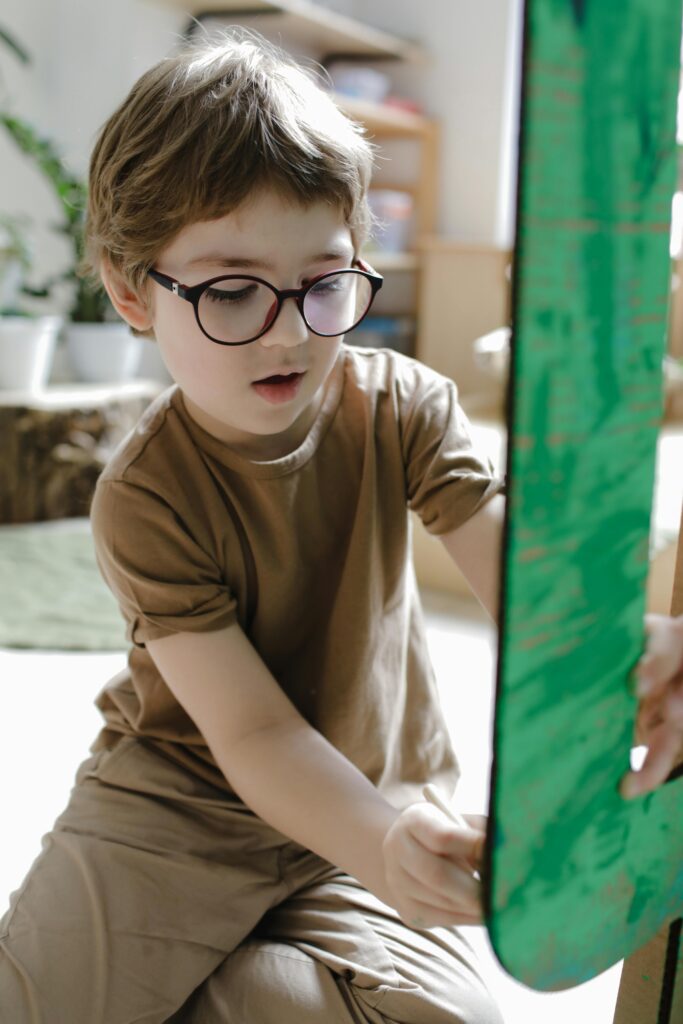
Why a Learning Corner Matters
Before I moved a single piece of furniture, I asked myself, Why bother? The answer was simple: children learn best when they feel safe, seen, and in control. A dedicated corner tells your child, This is your special place to wonder, build, and read. Experts in early‑childhood education note three big benefits:
- Focus – When all tools are within reach and distractions are out of sight, little brains settle faster.
- Order – Clear shelves teach sorting, matching, and the habit of returning items after use.
- Ownership – Kids are more willing to practise hard skills like writing if the area feels “theirs.”
At first, I thought we needed an entire playroom. Not true. One bright corner can become a miniature classroom that blends into family life. With those goals in mind, I got started.
Picking the Perfect Spot
Our living room has a sunny stretch next to a south‑facing window. That became learning land. I measured a rectangle roughly 1 meter by 1.5 meters—big enough for a rug, a shelf, and a tiny table. Four simple rules guided my choice:
- Light – Natural light keeps eyes healthy and moods happy.
- Calm – Far from the TV and kitchen clatter so he can concentrate.
- Sight Line – I can glance over from the sofa or stove without hovering.
- Safety Flooring – A washable cotton rug marks the boundary and cushions any tumbles.
If you have no free floor space, a fold‑down wall desk or a low bookshelf on wheels can do wonders. The key is consistency: the same spot every day trains the brain that “here we learn.”

Furniture Scaled to Small Bodies
Children sit straighter—and stay longer—when their furniture fits. I sketched a tiny table (55 cm high) and two chairs (30 cm seat height) and asked a local carpenter in Barishal to build them from lightweight pine. Rounded edges, water‑based varnish, and a coat of sage‑green paint made them both safe and cheerful.
Next came storage. I chose a low three‑tier shelf only 70 cm tall. That height lets Aanas see every tray without climbing. Each shelf is like a shop window: neat, open, and tempting. No lids, no deep boxes. When children can spot what they want in two seconds, they feel capable and avoid the “Mom, where is…?” chorus.
To finish, I slipped felt pads under the legs so the whole unit slides away for vacuuming. Total cost for table, chairs, and shelf: about ৳4,000 (≈ US $34).
Stocking the Shelves: Four Learning Lanes
I divided the shelf into four coloured lanes—blue, red, yellow, and green—each matching a core area of learning. Coloured paper circles on the shelf edges make sorting a game.
Blue Lane – Language & Reading
- Alphabet cards with vivid pictures. Each morning we pick three and hunt the matching letters in storybooks.
- A recycled cookie‑tin “sound box.” Inside are tiny objects—ant, button, coin—for guessing beginning sounds.
- Two sturdy picture books, rotated weekly.
Red Lane – Math & Logic
- Wooden counting rods from 1 to 10. We build stairs, name numbers, then knock them down.
- A ten‑frame board with marbles. Great for quick addition games.
- Pattern blocks and challenge cards I printed for free.
Yellow Lane – Art & Fine Motor
- Beeswax crayons and thick pencils that help tiny fingers practise tripod grip.
- Safety scissors with dotted cutting strips.
- Play‑dough in airtight jars, plus child‑size rollers and cookie cutters.
Green Lane – Science & Sensory
- A child’s magnifying glass taped to a sturdy lanyard so it never gets lost.
- Bottles filled with coloured rice, lentils, and tiny bells for shake‑and‑guess games.
- Nature treasures: leaves, feathers, smooth stones from our last walk.
Everything sits in shallow trays or baskets that slide out smoothly. Each item has only one purpose, which keeps choices simple and clear.
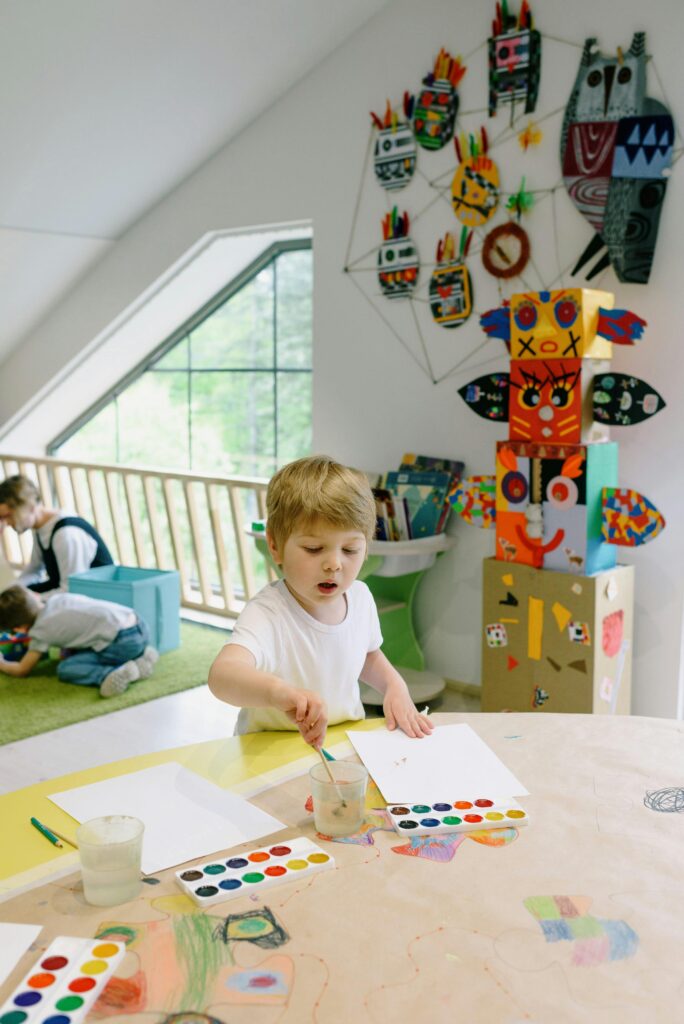
Rotation: Keeping Interest Fresh
Children thrive on novelty, but too many options cause overload. I use a 4‑plus‑4 rule: only eight trays remain on the shelf at any time—four open‑ended (like blocks) and four targeted (like counting cards). Every Sunday night I swap two or three trays with items stored in a sealed plastic bin under the bed. Suddenly “old” toys feel brand new. This gentle cycle keeps learning corners lively without constant spending.
Extra tip: snap a quick photo of each shelf arrangement before swapping. Photos act as visual cues for children when they tidy up, and they help caregivers reset the space correctly.
Building a Calm Zone & Movement Space
Young kids switch from high energy to fatigue in minutes. Right beside the shelf I hung a fabric swing pod rated for 40 kg. It doubles as a reading nest and a sensory swing. On the floor, a 120‑cm yoga mat becomes an instant hop‑scotch lane or stretching spot. A jar of beanbags and sticky wall dots above the mat invite gentle throwing practice—excellent for hand‑eye coordination.
When Aanas feels over‑excited, he sits in the swing with a calm‑down jar (water, glue, blue glitter). He watches the glitter settle, breathing slowly until he feels ready to play again.
A Day in Our Learning Corner
- 08:30 AM – After breakfast, we walk to the corner hand‑in‑hand. I light a small battery candle; it signals “learning time.”
- Free Choice (20 min) – Aanas picks any two trays. I sit nearby, sipping tea and observing silently.
- Shared Activity (15 min) – We read one book or play a quick counting game together.
- Clean‑Up Song (5 min) – We sing “This Is the Way We Tidy Up” while returning everything to its place.
- Afternoon Invitation (10 min) – After lunch, I set a single open invitation on the table—maybe shells and a scale, or letter stamps and dough—something fresh to spark curiosity.
- Evening Show‑and‑Tell (5 min) – Before bed, he shows his dad one creation or tells him something new he learned. This tiny ritual boosts language and confidence.
Consistency beats length. Even half an hour daily can plant big seeds of lifelong learning.
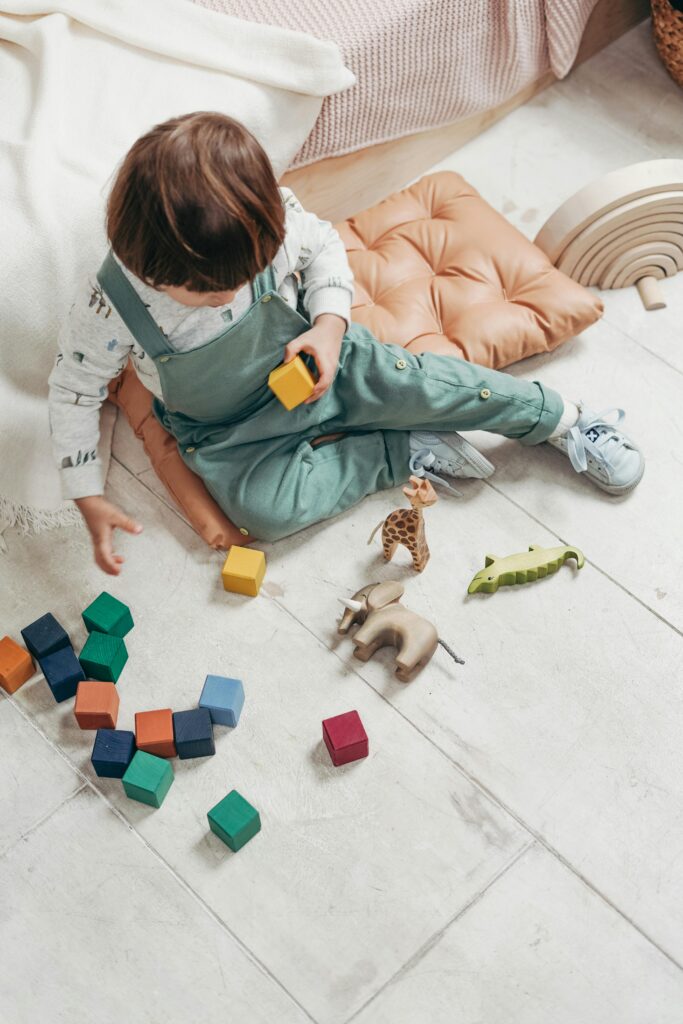
Decorating for Comfort, Not Clutter
I chose a soft palette—white walls, sage‑green furniture, and a natural jute rug. Too many bright colours can overwhelm young minds. To make the space feel personal, I framed three of Aanas’s paintings in cheap wooden frames sprayed white. Eye‑level art means he can admire his own progress.
Lighting matters after sunset, so I swapped the ceiling bulb for a daylight LED (4000 K) and added a desk lamp with a frosted shade to avoid glare. A single snake plant in a child‑proof clay pot brings nature indoors and teaches caregiving: every Sunday is Plant Watering Day.
Background music? Sometimes. I keep a small Bluetooth speaker on a high shelf and play soft instrumental tracks under 60 dB when focus lags.
Budget‑Friendly Tricks
Setting up a learning corner need not drain your wallet. Here are my favourite hacks:
- Cardboard Book Stand – Cut and fold an old cereal box, spray‑paint it white, and voilà: a face‑out display.
- Chalkboard Panel – A leftover plywood piece painted with matte black costs far less than a store‑bought board.
- Upcycled Jars – Empty jam jars sorted by lid colour become DIY sorting games (red lids for red items, blue for blue).
- Free Printables – Websites like Teachers Pay Teachers offer free alphabet cards; print two‑sided to save paper.
- Shared Toy Swaps – I trade puzzles with my neighbour every month so both kids enjoy “new” challenges at zero cost.
Our entire corner—including furniture, supplies, and decor—came in under ৳6,500 (± US $55).
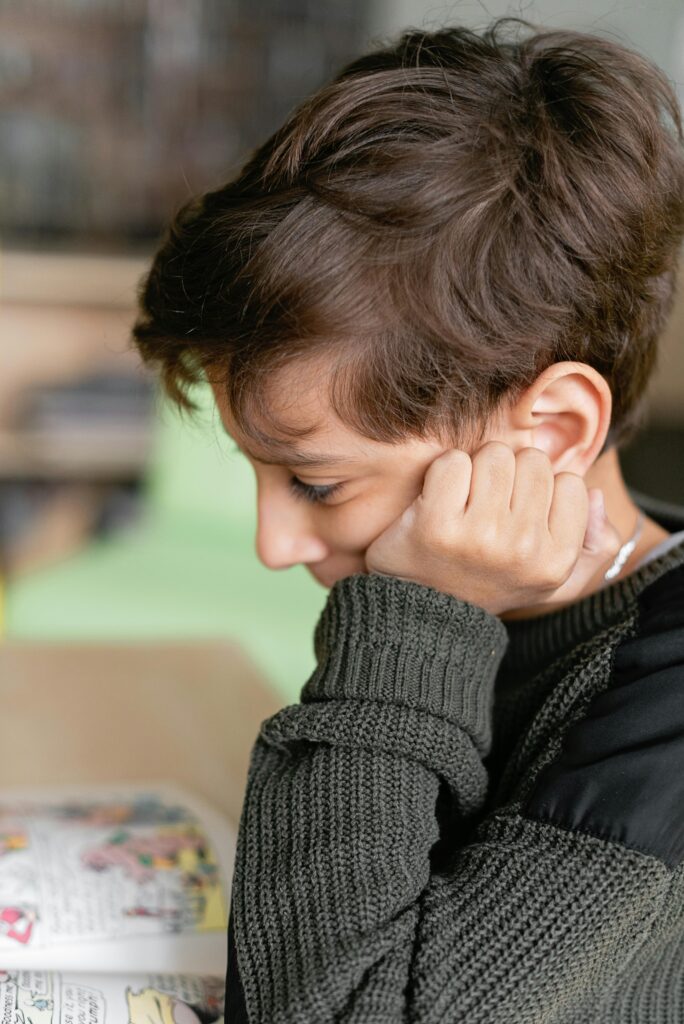
Growth I’ve Seen
Three months after launch, the corner has quietly transformed our days:
- Longer Focus – He now sits for 25 minutes on a tracing activity that used to bore him in five.
- Hand Strength – Thanks to play‑dough and tweezers, he can button his shirt by himself.
- Reading Joy – He chooses bedtime books on his own, pointing at letters and asking their sounds.
- Self‑Regulation – When frustrated, he heads straight to the calm‑down jar instead of shouting.
- Less Screen Time – Our TV stays off until evening because he never seems to run out of shelf ideas.

Final Thoughts
Setting up this learning corner has been less about perfect shelves and more about shared discovery. Each day, I watch Aanas light up when he masters a puzzle or invents a story with letter cards. I’ve learned that children don’t need grand playrooms; they need inviting spaces that respect their size, interests, and pace.
If you’re thinking about creating one, start small, observe, and adapt. Celebrate every tiny victory—whether it’s a neatly cut line or a quietly finished book. Over time, those victories weave a strong love for learning that will carry your child far beyond the corner’s cozy rug.
May your home become a little school of wonder, just as ours has.
Frequently Asked Questions
Q: How much space do I really need?
A tiny 1 m × 1.5 m slice of floor will do. Use wall shelves if floor area is super tight.
Q: My budget is small. What should I buy first?
Start with a child‑height shelf (or repurpose a low shoe rack) and a comfy rug. Add simple trays and homemade cards before splurging on fancy tools.
Q: At what age can I begin?
As soon as your child can sit and grasp objects—often around two years old—introduce safe sensory baskets. Add more complex activities as attention span grows.
Q: How do I keep it tidy?
Model clean‑up, use picture labels, and limit the number of trays. A five‑minute song works wonders.
Q: Do I need official Montessori materials?
They’re great but not essential. Household items—measuring cups, buttons, bottle caps—teach the same skills when presented thoughtfully.
Q: Does a learning corner replace preschool?
No. It complements school by turning home into a place of joyful practice and exploration.



